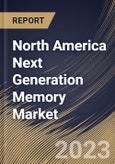In a rapidly evolving technological landscape, the need for faster, more reliable, and energy-efficient memory solutions has become increasingly pronounced. Traditional memory technologies, such as Dynamic Random-Access Memory (DRAM) and NAND Flash, have been the workhorses of the digital age. However, they are facing limitations, especially in the face of growing data volumes, artificial intelligence, and high-performance computing applications.
The latest developments in the market are a response to these challenges. They are rooted in the pursuit of memory solutions that can break through the bottlenecks associated with traditional memory technologies. Future memory technologies have the potential to completely change how data is handled, stored, and accessed in a variety of contexts, including data centers, autonomous cars, smartphones, and the Internet of Things (IoT).
The pursuit of non-volatile, high-speed, and high-density memory technologies has led to remarkable innovations. Among the prominent developments are technologies like Resistive Random-Access Memory (ReRAM), Phase-Change Memory (PCM), Magnetic Random-Access Memory (MRAM), and 3D XPoint memory. These technologies offer a spectrum of advantages, including lower power consumption, faster data access, and improved durability, making them suitable for various computing and storage needs.
Canada is experiencing significant growth in data-centric applications, particularly in natural resources, finance, and healthcare. The energy sector uses data-driven technologies for predictive maintenance and resource optimization. Financial institutions harness data analytics to make informed investment decisions and manage risk. In healthcare, data-centric applications aid medical research, drug discovery, and patient care.
In Mexico, data-centric applications are transforming industries such as manufacturing, agriculture, and logistics. Smart manufacturing processes utilize real-time data to enhance efficiency and product quality. Precision agriculture leverages data analytics to optimize crop management and resource allocation. Logistics and transportation companies rely on data-centric applications to streamline supply chain operations and enhance delivery routes. The growing adoption of edge computing underpins the expansion of data-centric applications, the Internet of Things (IoT), and 5G connectivity. These technologies require memory solutions capable of rapid data access and low latency, which has led to an increased demand for next-generation memory technologies.
The US market dominated the North America Next Generation Memory Market, By Country in 2022, and would continue to be a dominant market till 2030; thereby, achieving a market value of $4,119.1 million by 2030. The Canada market is exhibiting a CAGR of 19% during (2023 - 2030). Additionally, The Mexico market would experience a CAGR of 18% during (2023 - 2030).
Based on Technology, the market is segmented into Non-volatile (Magneto-resistive Random-access Memory (MRAM), Ferroelectric RAM (FRAM), SRAM, Resistive Random-access Memory (ReRAM), Nano RAM, and Others), and Volatile. Based on Wafer Size, the market is segmented into 300 mm, and 200 mm. Based on Vertical, the market is segmented into Enterprise Storage, Consumer Electronics, BFSI, Telecommunications, Information Technology, Government, Automotive & Transportation, and Others. Based on countries, the market is segmented into U.S., Mexico, Canada, and Rest of North America.
The market research report covers the analysis of key stake holders of the market. Key companies profiled in the report include Samsung Electronics Co. Ltd., Micron Technology, Inc., Fujitsu Limited, Toshiba Corporation, Honeywell International, Inc., Microchip Technology, Inc., Everspin Technologies, Inc., Infineon Technologies AG, Kingston Technology Company, Inc., and Intel Corporation.
Scope of the Study
Market Segments Covered in the Report:
By Technology- Non-volatile
- Magneto-resistive Random-access Memory (MRAM)
- Ferroelectric RAM (FRAM)
- SRAM
- Resistive Random-access Memory (ReRAM)
- Nano RAM
- Others
- Volatile
- 300 mm
- 200 mm
- Enterprise Storage
- Consumer Electronics
- BFSI
- Telecommunications
- Information Technology
- Government
- Automotive & Transportation
- Others
- US
- Canada
- Mexico
- Rest of North America
Key Market Players
List of Companies Profiled in the Report:
- Samsung Electronics Co. Ltd.
- Micron Technology, Inc.
- Fujitsu Limited
- Toshiba Corporation
- Honeywell International, Inc.
- Microchip Technology, Inc.
- Everspin Technologies, Inc.
- Infineon Technologies AG
- Kingston Technology Company, Inc.
- Intel Corporation
Unique Offerings
- Exhaustive coverage
- The highest number of Market tables and figures
- Subscription-based model available
- Guaranteed best price
- Assured post sales research support with 10% customization free
Table of Contents
Companies Mentioned
- Samsung Electronics Co. Ltd.
- Micron Technology, Inc.
- Fujitsu Limited
- Toshiba Corporation
- Honeywell International, Inc.
- Microchip Technology, Inc.
- Everspin Technologies, Inc.
- Infineon Technologies AG
- Kingston Technology Company, Inc.
- Intel Corporation
Methodology

LOADING...








